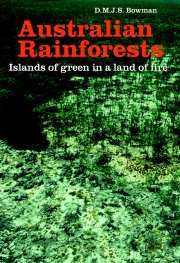Book contents
- Frontmatter
- Contents
- Preface
- 1 Introduction
- 2 What is Australian rainforest?
- 3 The sclerophyll problem
- 4 The edaphic theory I. The control of rainforest by soil phosphorus
- 5 The edaphic theory II. Soil types, drainage, and fertility
- 6 The climate theory I. Water stress
- 7 The climate theory II. Light and temperature
- 8 The fire theory I. Field evidence
- 9 The fire theory II. Fire, nutrient cycling, and topography
- 10 The fire theory III. Fire frequency, succession, and ecological drift
- 11 The fire theory IV. Aboriginal landscape burning
- 12 The fire theory V. Aridity and the evolution of flammable forests
- 13 The fire theory VI. Fire management and rainforest conservation
- 14 Summary
- References
- Index
2 - What is Australian rainforest?
Published online by Cambridge University Press: 23 November 2009
- Frontmatter
- Contents
- Preface
- 1 Introduction
- 2 What is Australian rainforest?
- 3 The sclerophyll problem
- 4 The edaphic theory I. The control of rainforest by soil phosphorus
- 5 The edaphic theory II. Soil types, drainage, and fertility
- 6 The climate theory I. Water stress
- 7 The climate theory II. Light and temperature
- 8 The fire theory I. Field evidence
- 9 The fire theory II. Fire, nutrient cycling, and topography
- 10 The fire theory III. Fire frequency, succession, and ecological drift
- 11 The fire theory IV. Aboriginal landscape burning
- 12 The fire theory V. Aridity and the evolution of flammable forests
- 13 The fire theory VI. Fire management and rainforest conservation
- 14 Summary
- References
- Index
Summary
The Europeans who colonised Australia had no conceptual frame with which to deal with the vast tracts of evergreen native vegetation that they came to, at Wrst disparagingly, then affectionately, call ‘bush’. The place name ‘Botany Bay’ attests to the impact that the ‘strange’ Australian flora had on the earlier explorers. In the nineteenth century, the dominant Australian vegetation aroused emotions of alienation, fear, despair, desolation, and melancholia in many observers. For example, the author Marcus Clarke wrote in 1876 that ‘The Australian forests are funereal, secret, stern. Their solitude is desolation … No tender sentiment is nourished in their shade …’ (Ritchie 1989). One exception was the luxuriant, cool and shaded forests that formed sanctuaries in the vast tracts of dry ‘monotonous’ bush (Ritchie 1989). In the nineteenth century these moist forests were known, not as ‘rainforests’ but by a range of terms including fern-forest, brush, scrub, and jungle (Adam 1992). In the twentieth century, the term ‘rainforest’ has been almost universally used and understood to denote an atypical Australian forest type. Sadly, we have limited appreciation of Aboriginal knowledge or terminology of Australian vegetation: only a few Aboriginal terms for Australian plant communities, such as ‘mulga’ and ‘mallee’, have been incorporated into the English language.
- Type
- Chapter
- Information
- Australian RainforestsIslands of Green in a Land of Fire, pp. 25 - 47Publisher: Cambridge University PressPrint publication year: 2000



